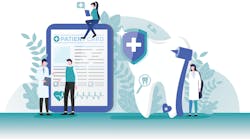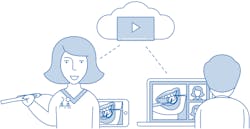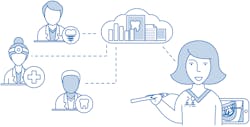Asynchronous teledentistry: It’s like a DVR for patient care
We’re accustomed to living in an on-demand world. We’ve been time-shifting TV programs since the introduction of the VCR. Today, we can watch virtually anything we want, anytime we want, by using the on-demand programming and recording options provided by our local cable system or DVR.
Wouldn’t it be great if the convenience and flexibility of on-demand and time-shifted movies and TV shows could be applied to treatment planning? Now, thanks to teledentistry, it can.
Teledentistry is the future of dental care and, believe it or not, the future is here. By using teledentistry platforms such as TeleDent (MouthWatch), we can provide enhanced dental care, dental consultations, patient education, and an increased overall public awareness of the importance of oral health. We can even generate new patients and revenue streams.
Yes, this all can be done live, which is called synchronous teledentistry—think real-time video or data review (figure 1). However, when we use teledentistry in asynchronous mode, we can time-shift patient visits and treatment planning to fit the busy schedules and travel itineraries of our internal and external patient care teams, as well as our patients (figure 2). Today’s dental patients are demanding more convenience and flexibility from their health-care providers, so it’s more important than ever to provide these conveniences to patients.
What is asynchronous teledentistry?
In a nutshell, asynchronous teledentistry involves collecting a patient’s clinical information and uploading it to the cloud, where it can be accessed and reviewed by dental professionals in other locations at any time. This is also known as store and forward.
With asynchronous teledentistry, we can safely and securely share patient information—including radiographs, intraoral photos, videos, and clinical data—with dental providers in remote locations so they can conduct a full clinical evaluation and develop a corresponding treatment plan.
As dental professionals, this enables us to streamline treatment planning, efficiently connect with our referral network, increase patient touch points, and create better access to dentistry for more patients.
Being more efficient
When using the asynchronous mode of teledentistry, we can be more efficient with the time we have with our patients. Time is always a hot commodity in the dental office, so being able to access all the information we need in a timely manner is essential.
We know that when patient information from previous visits with our office and visits with specialists are readily available, we get a full, clear picture of the patient, including his or her history, treatment plan, and goals. Having this information at our fingertips whenever we need it allows us to better treat our patients in a timely manner that is convenient to the team and the patient.
Speaking of being more efficient, utilizing asynchronous teledentistry makes connecting with our referral network simpler. A referral network can include a general dentist, orthodontist, endodontist, periodontist, and oral surgeon. But it can also include physicians, cardiologists, orthopedists, and any other health-care specialists. Having input from all of a patient’s providers helps create a comprehensive picture so we can better care for the patient and ensure optimal overall health.
Let’s say you referred your patient to an endodontist to evaluate a tooth for a possible root canal. The endodontist will create a treatment plan, which can be shared with you prior to performing any necessary treatment. Following the procedure, the endodontist will record the treatment completed and send that document, along with any radiographs, post-op reports, or follow-up instructions, directly to your office.
You may be thinking, “That’s what my office already does.” Well then, congratulations! You are already utilizing the asynchronous approach to some degree. However, with a teledentistry platform, you can bring this back-and-forth conversation between providers into the digital world, which will make you more efficient and, of course, HIPAA compliant. This information can now be shared immediately and reviewed later. With TeleDent specifically, patient data can be securely stored and retrieved using HIPAA-compliant, cloud-based software.
Here’s another example of something you may not already be doing. Let’s say a patient presents in your office and, while updating the health history information, tells you nothing has changed.
However, this patient had a knee replacement four months ago and failed to mention it. If your patient’s orthopedist were in your referral network, you would already have that information prior to the patient being seen in your office. You would have known ahead of time that this patient would require premedication based on the orthopedist’s recommendation.
Today, dentistry is focusing more and more on mitigating potential health risks, including heart attacks, strokes, Alzheimer’s disease, and many more conditions with an oral-systemic connection. Being in constant contact with a patient’s medical provider helps bridge the gap significantly and allows us to treat systemic conditions early on.
When providers share the patient data they collect, everyone benefits. Doctors and their teams benefit by streamlining appointment times and improving their workflows, while patients benefit by having all of their providers on the same page, caring for them in a holistic manner.
Access to dental care
Another huge benefit of using asynchronous teledentistry is having the ability to connect underserved patients with the dental care they need. This is especially helpful for patients who live in rural areas where there are fewer dental providers, more elderly people, and low (or no) dental coverage by insurance.
Hygienists are opting to serve their rural communities by collaborating with dentists remotely. With this method, a hygienist can see a patient, record all diagnostic information, and then send the data to the collaborating dentist for review and treatment planning.
Many patients are benefiting from this type of care because they can seek dental treatment more conveniently and at a lower cost. Based on supervision rules in your state’s dental practice act, supervision may not require real-time diagnosis and supervision by the dentist. In these cases, there may be more opportunities for dental hygienists to provide billable preventive-care services and see patients in a range of settings.
What’s more, there is a CDT insurance code for asynchronous teledentistry (D9996) as well as synchronous teledentistry (D9995). As with any treatment, insurance reimbursement is not guaranteed. But the ADA recommends using these codes consistently to help build a database of usage metrics that may result in more third-party payers reimbursing for teledentistry-delivered services. For more detailed information on teledentistry codes, refer to the ADA document, “D9995 and D9996 – ADA Guide to Understanding and Documenting Teledentistry Events.”
Conclusion
By educating yourself on the utilization of asynchronous teledentistry, you can see how implementing this into your practice can be a seamless transition, without occupying valuable time in your already busy office. With this streamlined approach, you can conveniently and efficiently care for more patients in any location.










